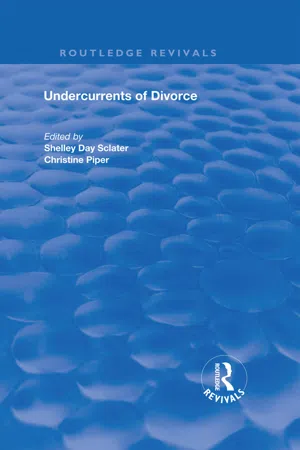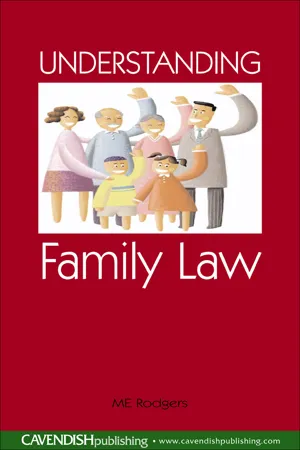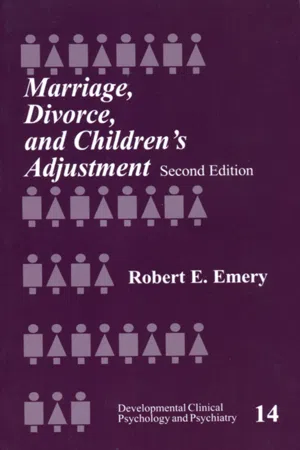History
1969 Divorce Reform Act
The 1969 Divorce Reform Act was a significant piece of legislation in the United Kingdom that made it easier for couples to obtain a divorce. It introduced the concept of irretrievable breakdown of marriage as the sole ground for divorce, allowing couples to divorce after a separation period of two years with mutual consent or five years without. This act marked a major shift in divorce law and had a lasting impact on family law in the UK.
Written by Perlego with AI-assistance
Related key terms
8 Key excerpts on "1969 Divorce Reform Act"
- eBook - ePub
- Shelley Day Sclater, Christine Piper(Authors)
- 2019(Publication Date)
- Routledge(Publisher)
The removal of fault from divorce has not been and will not be, we suspect, easy to achieve. One of the central aims of the Divorce Reform Act of 1969 was the removal of matrimonial fault. That Act introduced ‘irretrievable breakdown’ as the sole ground for divorce but, such was the heated and ideological nature of the debates as the Bill passed through Parliament, that fault, in fact, lived on in the guise of the ‘facts’ required to prove the irretrievable breakdown. Similarly, the passage of the 1996 Act was troubled by a vocal lobby who argued that removal of fault represented an undermining of marriage and ‘the family’. This lobby was undoubtedly placated by the introduction of the ‘principles’ at the Report stage, which include a provision that ‘the institution of marriage is to be supported’ (now in section 1 of the Act), but this principle, coupled with the removal of fault, conveys powerful messages in which many tensions are manifest. The removal of fault from the legal process represents a legislative expression of the primacy of a discourse of harmony and one that prioritises a particular interpretation of children’s interests. The principle that marriage is to be supported connotes a concern that marriage should remain the preferred basis for ‘the family’ and the best forum for raising children. But the passionate nature of the divorce debates, in 1969 and in 1996, indicate that in the popular mind at least, fault remains important and significant in divorce. As in 1969, we may find that we are not able to legislate it away.At an individual level, studies show that divorcing people are deeply concerned about issues of blame, which colour their perceptions of fairness and their ideas about justice (see, for example, Davis, Cretney and Collins, 1994). For many, the notion of fault, of attributing blame to one party and exonerating the other, is what the legal system should be about, it is what ensures that justice is not only done but also is seen to be done. Brown and Day Sclater, in their chapter on the psychodynamics of divorce, argue that there are good psychological reasons why many divorcing people feel this way; faced with the loss that divorce inevitably entails, as well as the need to build a new life, the imputation of blame can feature prominently on the psychological agendas of divorcing people. These psychological ‘roots’ provide a bedrock for a culture in which divorce is pathologised and where fault goes hand-in-hand with divorce. There is clearly a tension between the kind of harmonious divorce that is envisaged for us, and the needs and expectations of divorcing people. - eBook - ePub
Divorce and Remarriage in the Bible
The Social and Literary Context
- David Instone-Brewer(Author)
- 2002(Publication Date)
- Eerdmans(Publisher)
The husband would hire a hotel room, a woman, and a private detective with a camera who would “discover” the “adulterer” and provide evidence for the court. This brought the law into disrepute, and so the Anglican Church report Putting Asunder recommended that the principle of “irretrievable breakdown” of marriage should supplant the concept of “matrimonial offenses.” This was implemented in the Divorce Reform Act 1969, which said that “irretrievable breakdown” should be demonstrated by adultery, intolerable behavior, desertion for two years, separation for two years, or separation for five years if one party contests the divorce. The Family Law Act of 1996 still recognized “irretrievable breakdown” as the sole ground for divorce but removed the need to prove it in an effort to make divorce less litigious. It also introduced compulsory counseling and additional cooling-off periods. However, this reform was found to be unworkable, and the act was withdrawn before it was fully implemented. In the United States the trend went in the opposite direction until 1969. Instead of fewer grounds there were a bewildering number of possible grounds for divorce because each state had its own laws. Donald W. Shaner estimated that there were more than thirty different grounds that were recognized in one or more states. 43 This was in 1969 when Ronald Reagan, then governor of California, signed the first no-fault divorce law, which has since spread throughout the United States. With this change in the law, the divorce rate jumped dramatically. The Growth in Divorces Similar evolutions of the law have taken place in most other countries in the world, making divorce less expensive and less complicated. As a result there has been a huge growth in the number of divorces. This increase has often been interpreted as a sign of modern immorality, or lack of determination to make marriages work - eBook - ePub
Mediation in Family Disputes
Principles of Practice
- Marian Roberts(Author)
- 2016(Publication Date)
- Routledge(Publisher)
— to minimize the harm that the children may suffer both at the time and in the future and to promote so far as possible the continued sharing of parental responsibility for them (Law Commission, 1990, p. 2); this objective was fundamental also to the Children Act 1989.The Law Commission Report recommended that irretrievable breakdown of marriage remains the sole ground for divorce. In a radical departure from the existing law, the Report and its accompanying draft Bill introduced, with the overwhelming support of the vast majority of consultees, the period of consideration and reflection - the ‘cooling off’ period or breathing space - as a new way of demonstrating irretrievable breakdown of marriage. Within this period of consideration and reflection, the parties’ own responsibility for decision-making was given central emphasis. The other radical innovation of the proposals was the incorporation of mediation as ‘an important element in developing a new and more constructive approach to the problems of marital breakdown and divorce’ (Law Commission, 1990, para. 7.24). These proposals were subsequently incorporated into the Green Paper, the White Paper on Divorce Reform (both of which were titled Looking to the Future: Mediation and the Ground for Divorce) and then the proposed Family Law Act 1996. Despite the hope that the Family Law Act promised for introducing a ‘good’ divorce law, those divorce reform sections were not enacted. (For further discussion on the Family Law Act and on other legal developments, see Chapter 3 .)Notwithstanding the shelving of the Family Law Act 1996, respective governments have sought to shift family justice in directions away from litigated and adjudicated outcomes and towards settlement by parties themselves with the intention to improve the welfare of children and protect vulnerable people at stressful times (see for example, numerous consultation papers, working papers and reports,3 and legislation4 ). One such direction is towards ‘early dispute resolution’ with family disputes arising from divorce and separation kept away from the courts and within the domain of decision-making by couples themselves wherever possible (Private Law Programme, 2004; Walsh, 2006). As in North America, two themes, often intertwined, can be discerned informing the impetus behind official enthusiasm for mediation in family disputes and in the civil justice system in Britain (Woolf, 1995). The ‘warm theme’ celebrates mediation as a potentially superior method of dispute resolution and refers to the ‘impulse to replace adversary conflict by a process of conciliation to bring the parties into mutual accord’ (Galanter, 1984, p. 2). The ‘cool theme’ emphasizes administrative efficiency and cost-savings (for example, in the reduction of court hearings, welfare reports and legal aid) at a time when matrimonial disputes have accounted for two-thirds of the civil legal aid outlay5 - eBook - ePub
- Liz Rodgers(Author)
- 2012(Publication Date)
- Routledge-Cavendish(Publisher)
As you may be aware, the law on divorce has been subject to review over the last few years. The Family Law Act (FLA) 1996 was enacted with one of its aims being to change the divorce regime and to support the institution of marriage. While a large part of the FLA has been brought into force, Pt II, the part that dealt with divorce, was left unimplemented. Primarily this was to enable pilot studies to be carried out as to the best method for implementation. These pilot studies, and the accompanying research, were not favourable and hence Pt II of the FLA 1996 will, at some point, be repealed. This means that the Matrimonial Causes Act (MCA) 1973, despite criticism, remains in force and it is this Act’s provisions that establish how a divorce can be obtained. In addition to studying the MCA 1973 you will look briefly at the FLA 1996, but this will be to enable you to understand why the reform failed and it will assist you in learning how to evaluate the law in a critical way. You should try to approach this part of the text on the basis of why the FLA’s principles were so unworkable, and whether anything beneficial could come from it, etc. You will also be looking at mediation, a FLA concept for resolving issues in divorce, this being one of the parts of the FLA 1996 that are fully in force and operational.3.2 A HISTORICAL PERSPECTIVEEngland and Wales are perceived to have a high divorce rate – the number of divorces granted in 2003 being in excess of 148,000, although this is a fluctuating figure. This number of divorces is seen as being detrimental to the stability of family life and, indeed, detrimental to the family per se. The ability to seek a divorce, for the majority of couples who wish to do so, is a relatively recent development. Historically, divorce was available only to a few, those rich enough to obtain a Private Act of Parliament, and was often only an option for the male partner. In 1857 the concept of judicial divorces was introduced, being available where one party to the marriage was guilty of adultery and the petitioning spouse was free from any guilt. A move away from adultery as a basis for divorce came in 1937 with a widening of the categories, although the categories were all a ‘matrimonial offence’, such as cruelty, desertion, insanity or adultery. The modern law stems from the Divorce Reform Act (DRA) 1969 and was re-enacted without change in the MCA 1973. This change was intended to move away from the idea of a matrimonial offence as a basis for bringing the marriage to an end.Following the full introduction of the DRA 1969, the number of divorces increased although not immediately. However, there was over a threefold increase in decrees granted between 1968 and 1978. The Law Commission has pointed out that whilst it may be easy to blame changes to the divorce laws for increasing marital breakdown, a change to divorce law and the number of divorces are not necessarily linked and you may find it useful to look at the paper (Law Commission Discussion Paper, Facing the Future – A Discussion Paper on the Ground for Divorce - eBook - ePub
- Joanna Miles, Daniel Monk, Rebecca Probert, Joanna Miles, Daniel Monk, Rebecca Probert(Authors)
- 2022(Publication Date)
- Hart Publishing(Publisher)
But what happens when it is well known that a divorce will be available sooner or later should either of the parties to the marriage wish to end it, regardless of whether anything can be alleged against the other? How do novelists engage with and depict the legal process of ending a marriage when there is no uncertainty as to whether their characters will be able to do so, and no courtroom scenes to add drama to the narrative? This chapter draws on over 50 novels and collections of short stories published since the Divorce Reform Act came into force in 1971, to explore how the story told about the law has shifted since ‘irretrievable breakdown’ became the sole ground for divorce, albeit one that had to be evidenced by demonstrating one of five facts. It shows that while a distinct shift in emphasis can be seen from previous depictions of divorce law in several respects, the overarching story being told about the law both before and after reform is how far it is divorced from reality.The first and most striking change within the post-reform literature is the normalisation of divorce, as reflected not only in the frequency with which divorces feature in these novels but also in how they are discussed. The second is the way in which individuals are depicted as engaging with the law. From the 1970s onward, the courtroom scene disappeared from fictional depictions of divorce to the same extent as it did from the law, that is to say, almost completely; lawyers still featured as sources of advice, but the way in which they were portrayed suggested a certain ambivalence about their role, and there was a growing emphasis on the importance of resolving matters amicably. This brings us on to the common thread running through fictional depictions of the law before and after 1971: their focus on the law’s artificiality. The facts that had to be established under the Divorce Reform Act 1969 may have been easier to satisfy than the grounds required under the previous law, but characters still found themselves baffled by what the law regarded as sufficient to justify the ending of a marriage. Alongside this continuity, however, was a shift in focus in the literature from the spouse who wanted the divorce to the spouse who did not, and to the way in which divorce plots were resolved.These four themes will be considered in turn. Before doing so, however, I should say something about the corpus of novels and stories on which I draw. Some were chosen specifically because they had ‘divorce’ in the title or otherwise alluded to multiple marriages.2 The titles are themselves significant, as is the fact that they are concentrated in the past 20 years: the decision to allude to divorce in the title of these particular novels could be seen as a ploy to tap into a particular market, reflecting the authors’ perceptions of just how common divorce has become.3 - eBook - ePub
- Robert E. Emery(Author)
- 1999(Publication Date)
- SAGE Publications, Inc(Publisher)
This chapter is organized around three general topics. First is an overview of the government’s role in regulating divorce. Central issues include the grounds for divorce and broader questions about whether the state should promote marriage and discourage divorce (and nonmarital childbirth). Second, the chapter reviews divorce settlements and related efforts to provide economic and parenting support to children from divorced families. Key topics include physical custody (residence and visitation), legal custody (parental authority), and the economic obligations of divorced parents to each other and their children. Finally, the process of settling divorce disputes is considered, especially the contrast between traditional adversary settlement and divorce mediation.The chapter highlights key developments in law and policy in the United States in the past two decades, but it also includes some discussion of history and proposals for reform. The inclusion of this material is intended to convey a sense of both past developments and future directions of divorce and family law.THE REGULATION OF DIVORCEUntil the 20th century, the primary goal of divorce law was to uphold marriage by making divorce difficult (Halem, 1981). In much of Europe, the Catholic Church both prohibited divorce among its members and influenced civil regulations on divorce; these regulations were essentially determined by the Church from the Middle Ages until the Reformation (Eekelaar, 1991). Even after the Reformation, a divorce was granted only when one party was at fault as judged by narrow grounds, typically adultery, cruelty, or heresy (Eekelaar, 1991). The low incidence of divorce through the 19th century speaks to the deterrent effect of the regulations (Eekelaar, 1991; Halem, 1981).The activist approach that characterized the religious and civil regulation of divorce for hundreds of years was replaced with a more reactive policy during the 1900s. Faced with the practical problem of deciding an ever-increasing number divorce actions, the judiciary slowly accommodated changing social attitudes by using increasingly broad interpretations of the grounds for divorce (Plateris, 1974). - eBook - ePub
The Eclipse of a Great Power
Modern Britain 1870-1992
- Keith Robbins(Author)
- 2014(Publication Date)
- Routledge(Publisher)
Linked to these regional and national divisions were other divisions which seemed to some commentators to be as defining of the Thatcher years as the ‘enterprise culture’. Indeed, perhaps the two were inextricably linked. Those very incentives and deregulation initiatives of which the government was so proud served to deepen divisions of wealth, health and welfare. These in turn were related to poor skills, poor opportunities and the breakdown of family life in the form of accelerating divorce (from which the royal family was conspicuously not exempt) and illegitimacy rates. There was much argument about the extent to which family disintegration was a cause or a consequence of many of these conditions. What could not be disputed were the facts which showed a dramatic change. In 1963 there were a mere 23,000 divorces in England and Wales. Thirty years later it was a normal assumption that one in three marriages would end in divorce. The 1971 Divorce Law Reform Act had of course made divorce easier. It might also be argued that the ‘real’ as opposed to the ‘legal’ breakdown had not changed so dramatically. Although there was an increasing acceptance of various kinds of relationship which stopped short of marriage, the incidence of re-marriage suggested that the institution itself was not as dead as some commentators supposed(296). The one-parent family, however, was now an established and commonplace phenomenon. The legalization of abortion, subject to certain constraints, which had been enacted in 1968, resulted in a normal pattern of more than 100,000 terminations per annum and remained a topic of passionate debate.Alongside these developments went an apparently inexorable rise in recorded crime and the seeming inability of the police, despite increased resources, to contain it. In turn, perhaps as a result of the pressure they were under, cases of police misconduct and corruption contributed to a sense of malaise. The greatest source of concern was the rise in crimes against the person, and vandalism. Even when every allowance had been made for the difficulties in interpreting statistics – was there more crime or more recorded crime? – the picture was disturbing and, for many, frightening. In a single year, 1986–87 crimes against the person increased by 12 per cent. Other indicators of social stress were not lacking. Although figures are again difficult to be dogmatic about, the number of alcoholics was apparently steadily rising – perhaps three-quarters of a million in Britain. Although fashions in drug-taking appear to have fluctuated, experimentation among the young was thought to be widespread. Heavy drugs in turn produced in some quarters a drug culture. It was widely supposed that a considerable portion of the increase in crime could be explained, at least in urban areas, by the need to finance to drug habit. Against these trends, it was possible to note a very considerable shift away from smoking – at least among men. A considerable change in public attitudes to drinking and driving was also detectable. - eBook - ePub
Divorce, Families and Emotion Work
'Only Death Will Make Us Part'
- Elena Moore(Author)
- 2017(Publication Date)
- Palgrave Macmillan(Publisher)
2009 ). I show how the timing of Irish divorce legislation greatly influenced the design of the law because the Irish legislature learned valuable lessons from other jurisdictions. The legislature did not merely reproduce the legislation from other jurisdictions. Instead it crafted a unique restrictive divorce regime which would uphold the sanctity of marriage. At the same time the belated introduction of divorce into Irish law allowed the legislature to focus on three major concerns found in the international literature about divorce in the early 1990s: (1) the risk of poverty; (2) parental conflict and the impact on the child; and (3) the need to promote and encourage shared parenting and parent–child contact.Getting Tough on Divorce and Policing Families
As a latecomer to divorce and much to the surprise of legal experts (Shannon 2008 ), Ireland opted for a no-fault-based divorce in 1995, hoping to reduce parental conflict, which was believed to be inflated by a fault-based system.3 The shift from fault-based divorce was part of a major shift in thinking about the extent to which the law could, or should, impose certain standards of behaviour in personal relationships. The move away from assigning fault prioritised a higher morality within, rather than a traditional code imposed by, the law. The 1960s and 1970s generally saw a liberalisation of family law allowing the introduction of easier, no-fault divorces. Relaxing the divorce laws meant that either party could demand a divorce and did not require the consent of both parties (although in some regions a lack of consent increased the time of separation required before one could divorce). Over the two decades that followed, further research concentrated on how the no-fault-based system advantages one group over the other. Weitzman (1985 ) in the USA and Eekelaar and Maclean (1986 ) in the UK showed how much men gained and how much women lost at the point of divorce (which encouraged opportunistic behaviour among men).Divorce in Ireland is tightly controlled and the requirements for exiting a marriage are extremely restrictive (Ward 1995 ). The conditions or grounds for divorce under Section 5 of the Family Law (Divorce) Act 1996 are as follows: (1) separation for four years; (2) no prospect of reconciliation; and (3) proper provision for the children and the other spouse. The court will grant the divorce only if it is satisfied that the parties have fulfilled these requirements. Comparing the requirements for exiting a marriage across a range of EU states highlights the diversity of approaches to divorce and the specific sociocultural approaches across the region (see Table 2.9 ). The comparison also helps to identify the idiosyncrasies of the Irish context and other Catholic societies.Table 2.9 EU member state laws for the grounds for divorceNo ground required
Learn about this page
Index pages curate the most relevant extracts from our library of academic textbooks. They’ve been created using an in-house natural language model (NLM), each adding context and meaning to key research topics.







